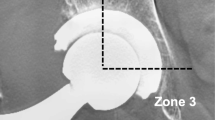Abstract
The aim of this study was to evaluate the inter- and intra-observer variability and to find differences in diagnostic safety between digital and analog technique in diagnostic zones around hip prostheses. In 80 patients who had had a total hip replacement (THR) for more than 2 years, a conventional image and a digital image were taken. Gruen’s model of seven distinct regions of interest was used for evaluations. Five experienced radiologists observed the seven regions and noted in a protocol the following distances: stem–cement; cement–bone; and stem–bone. All images were printed on hard copies and were read twice. Weighted kappa, κw, analyses were used. The two most frequently loosening regions, stem–cement region 1 and cement–bone region 7, were closely analyzed. In region 1 the five observers had an agreement of 86.75–97.92% between analog and digital images in stem–cement, which is a varied κw 0.29–0.71. For cement–bone region 7 an agreement of 87.21–90.45% was found, which is a varied κw of 0.48–0.58. All the kappa values differ significantly from nil. The result shows that digital technique is as good as analog radiographs for diagnosing possible loosening of hip prostheses.



Similar content being viewed by others
References
Kotter E, Langer M (2002) Digital radiography with large-area flat-panel detectors. Eur Radiol 12:2562–2570
Pettersson H (1992) Digital skeletal radiography. In: Resnick D, Pettersson H (eds) Skeletal radiography, NICER series on diagnostic imaging. Merit Communications, London, pp 1–8
Jónsson A, Borg A, Hannesson P, Herrlin K, Jonsson K, Sloth, M, Pettersson H (1994) Film-screen vs digital radiography in rheumatoid arthritis of the hand: an ROC analysis. Acta Radiol 35:311–318
Jónsson A, Hannesson P, Herrlin K, Jonsson K, Andersen R, Pettersson H (1995) Computed vs film-screen magnification radiography of fingers in hyperparathyroidism: an ROC analysis. Acta Radiol 36:290–294
Pettersson H, Aspelin P, Boijsen E, Herrlin K, Egund N (1988) Digital radiography of the spine, large bones, and joints using stimulable phosphor; early clinical experience. Acta Radiol 29:267–271
Van der Jagt EJ (2000) Can we see enough? A comparative study of film-screen vs digital radiographs in small lesions in rheumatoid arthritis. Eur Radiol 10:304–307
Langen HJ et al. (1993) Comparative evaluation of digital radiography vs conventional radiography of fractured skulls. Invest Radiol 8:686–689
Swee RG (1997) Screen-film vs computed radiography imaging of the hand: a direct comparison. AJR 168:539–542
Zähringer M, Krug B, Kamn KF, Wassmer G, Hellmich M, Winnekendonk G, Andermahr J, Gossmann A, Lackner KJ (2001) Detection of porcine bone lesions and fissures: comparing digital selenium, digital luminescence, and analog film-screen radiography. AJR 177:1397–1403
Hamers S et al. (2001) Digital radiography with a large-scale electronic flat-panel detector vs screen-film radiography: observer preference in clinical skeletal diagnostics. Eur Radiol 11:1753–1759
Strotzer M et al. (2000) Simulated bone erosions in a hand phantom: detection with conventional screen-film technology vs cesium iodine-amorphous silicon flat-panel detector. Radiology 215:512–515
Okamura T et al. (2001) Clinical evaluation of digital radiography based on a large-area cesium iodide-amorphous silicon flat-panel detector compared with screen-film radiography for skeletal system and abdomen. Eur Radiol 12:1741–1747
Piraino DW (1999) Selenium-based digital radiography vs conventional film-screen radiography of the hands and feet: a subjective comparison. AJR 172:177–184
Testoni M (2000) Evaluation of radiolucency condition in total hip arthroplasty: a statistical comparison of the diagnostic capability of digitised image vs conventional X-ray film. Eur Radiol 10:601–608
Gruen TA, McNeice GM, Amstutz HC (1979) “Modes of failure” of cemented stem-type femoral components: a radiographic analysis of loosening. Clin Orthop Relat Res 141:17–27
Altman D (1991) Practical statistics for medical research. Chapman and Hall, London, p 406
Chevrot A (1992) Total hip replacement. In: Resnick D, Pettersson H (eds) Skeletal radiography, NICER series on diagnostic imaging. Merit Communications, London, pp 594–614
Pfahler M, Schidlo C, Refior HJ (1998) Evaluation of imaging in loosening of hip arthroplasty in 326 consecutive cases. Arch Orthop Trauma Surg 117:205–207
Acknowledgement
The authors thank P.-E. Isberg, Department of Statistics, Lund University, for help with the statistics.
Author information
Authors and Affiliations
Corresponding author
Rights and permissions
About this article
Cite this article
Eklund, K., Jonsson, K., Lindblom, G. et al. Are digital images good enough? A comparative study of conventional film-screen vs digital radiographs on printed images of total hip replacement. Eur Radiol 14, 865–869 (2004). https://doi.org/10.1007/s00330-003-2126-y
Received:
Revised:
Accepted:
Published:
Issue Date:
DOI: https://doi.org/10.1007/s00330-003-2126-y




